I’ve Never Played A Survival Horror
- Updated: 17th Feb, 2012
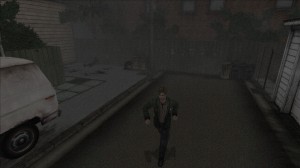 I’m 22 years old, I’ve been obsessed with games since I was 4, I’ve even studied Game Development and Game Design in college. I… this is kind of hard to admit…
I’m 22 years old, I’ve been obsessed with games since I was 4, I’ve even studied Game Development and Game Design in college. I… this is kind of hard to admit…
I’ve never played a survival horror game before. In particular, I’ve never played Silent Hill 2 (SH2), which is perceived by many to be the genre’s pinnacle.
Modern survival horror begins with Resident Evil (RE), released in 1996. I was 7, and owing to a sheltered childhood entirely free of zombie attacks, I don’t believe that I’d even heard of a zombie at the time. When I was maybe 9 or 10. I did try out a demo of RE2. I flailed around uselessly for a while, battling with the control scheme, and was quickly eaten. The disc was ejected, and forgotten about.
Silent Hill 2 released in 2001, when I was 11. I was fully aware of the series. I read the reviews, and came to the conclusion that I didn’t want to play a game that controlled as badly as these games were said to do. I also concluded that the level of terror described in the media coverage was far too much for my 11-year-old self to cope with. Perhaps another reason for my avoidance was that I was under the illusion that I didn’t like horror as a genre of anything.
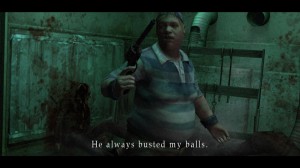 Conventional Western horror can be boiled down to jump scares, and gore. Sitting down for 90 minutes to watch predictable (in that they were generally stabbings) and unpleasant things happen to people never appealed. It wasn’t interesting, with very little plot, very little characterisation, but plenty of stabbing. Even Japanese horror failed to really impress. It was more interesting plot-wise, but had no emotional impact on me at all.
Conventional Western horror can be boiled down to jump scares, and gore. Sitting down for 90 minutes to watch predictable (in that they were generally stabbings) and unpleasant things happen to people never appealed. It wasn’t interesting, with very little plot, very little characterisation, but plenty of stabbing. Even Japanese horror failed to really impress. It was more interesting plot-wise, but had no emotional impact on me at all.
The Silent Hill HD collection was supposed to come out last month. However, Konami in their infinite wisdom decided to push it back to March. What was I going to do? I was excited for it. I ended up cancelling my preorder and buying the PC version of the original game.
Feel and charm are the two most important things I look for in games. Zelda games are the gold standard here. In particular, during the opening half hour you’re not really doing anything at all. You’re walking around a bit looking at the art-style and you have the few basic tutorials. I spend this time walking around with a big stupid grin on my face! I can’t really explain, or point out any single thing that’s causing it, but the openings of Zelda games, particularly A Link To The Past, are utterly charming.
SH2’s opening feels like the photo-negative of the Zelda games. It opens in the worst public toilet toilet ever, complete with door kicked off its hinges. Once the opening monologue is over, the player begins The Walk To Silent Hill.
Silent Hill 2 focuses on a guy called James. He has received a letter from his wife asking him to meet her in their special place in the town of Silent Hill. There is one problem – she’s been dead for 3 years. Despite this, James has driven to the outskirts of the town.
The Walk To Silent Hill is a great example of how giving the audience even the most basic agency enhances the tricks of the psychological horror trade a thousand-fold. The Walk is just that – a walk to the town of Silent Hill.
Gameplay consists of camera control and moving James. James received a letter from his wife, asking him to meet her in Silent Hill in their special place. The combination of gameplay elements during this walk made me feel that I was in this world. As a result I was affected much more than if I was simply watching someone walk through a forest park.
The most noticeable of these elements is the fog. SH2 is famous for its fog, so going in, I was prepared for fog. Nothing can prepare you for SH2’s fog! The cliché here would be to say that the fog is oppressive, but oppressive really is the most apt term. It’s the thickest fog in video games; you really cannot see more than 5-6 feet ahead.
The removal of your vision as a useful tool, really enhances the second most noticeable element of Silent Hill’s world: Akira Yamaoka’s sound design. As you walk through the park, Yamaoka uses two tracks; “White Noize”, and “Forest”. Both are unsettling and feel like the product of an evil laboratory with a research grant to develop sounds that panic humans. Walking through this gloomy wood, unable to see, unsettled by the music and the occasional scritching, I was on edge from the start and very jumpy, constantly expecting an attack that never came.
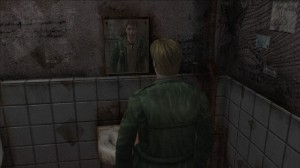 Soon after arriving in Silent Hill, I became very aware that I was alone in this town. It’s one of the most powerful feelings I’ve experienced in video-games. It felt cinematic or novelistic, certainly not like something from a game. Games tend to be very busy: “Pay attention to this”, “Kill that”. For large parts of my time with it, SH2 has left me alone. Novels in particular, have the space for sections where not a whole lot happens. Sounds boring doesn’t it? However, in a place as foreboding and fascinating as Silent Hill, getting to slow down and just be in it feels incredibly innovative and exciting. Ghost towns fascinate me, so being left alone in one save for the occasional monster felt great.
Soon after arriving in Silent Hill, I became very aware that I was alone in this town. It’s one of the most powerful feelings I’ve experienced in video-games. It felt cinematic or novelistic, certainly not like something from a game. Games tend to be very busy: “Pay attention to this”, “Kill that”. For large parts of my time with it, SH2 has left me alone. Novels in particular, have the space for sections where not a whole lot happens. Sounds boring doesn’t it? However, in a place as foreboding and fascinating as Silent Hill, getting to slow down and just be in it feels incredibly innovative and exciting. Ghost towns fascinate me, so being left alone in one save for the occasional monster felt great.
SH2’s use of monsters in its exterior sections is very interesting. It takes the opposite approach to Dead Rising, which floods the game world with thousands of zombies. SH2 provides a much sparser distribution of monsters, 2 or 3 on a street at most. What this does, is it normalizes the situation, and in a strange way make it more believable. The malls and casinos in Dead Rising are still human spaces, but they are filled with zombies. Its very jarring, which is the effect the developers were going for. Silent Hill on the other hand, feels like a town that has been completely taken over by something evil. It’s no longer an event, it’s the norm. The monsters are just casually going about their business. The developers have managed to turn the limitations of the original hardware (the PS2 had very little memory) to their advantage.
This normalization of the situation really adds to the feeling of being behind enemy lines. Usually when I play games I glance at the map once, and then head in the general direction of the objective. Not here. Journeys are planned, the map is checked all the time. Picking the best route and then executing it efficiently and safely feels very important. Executing the routes safely touches on SH2’s only reward mechanism thus far; the feeling you get when you dodge past monsters.
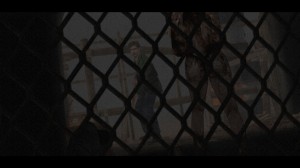 Avoiding combat is the signature thing about survival horror but I didn’t really appreciate how much it can add to a game until I was running down a foggy street, weaving between monsters, and just about avoiding panic. Okay, panicking a little. Successfully avoiding combat makes you feel smart, responsible, and further enhances the believability of the game.
Avoiding combat is the signature thing about survival horror but I didn’t really appreciate how much it can add to a game until I was running down a foggy street, weaving between monsters, and just about avoiding panic. Okay, panicking a little. Successfully avoiding combat makes you feel smart, responsible, and further enhances the believability of the game.
Silent Hill 2 is a weird combination of brilliant experience design, and terrible game design. On the one hand, this might be the most immersive game I’ve played. On top of the great fog, great sound design and unparalleled feeling of loneliness, SH2 removes the chief opponent of immersion in gaming; the HUD. In a nice touch, the player’s health is represented not by an arbitrary number, but by a menu pane displaying James’ view of the world. Its condition (colour and level of interference) tells you what state James is in.
The mastery in experience design is shown off to best effect with the psychological scares. The developers have provided sensory inputs, and trust that you’ll be frightened at the right times. This is stupidly brilliant! It’s brave, innovative, and executed superbly. These may be the tricks of the psychological horror trade, but to use them when the player has control over so much (pacing, location, deciding to spin in circles) is laudable. Player agency is what makes it work, but could so easily spoil the whole thing. Somehow the developers have got me to play along; they got to have their cake, and eat it.
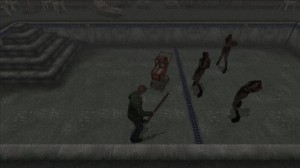 Sadly, gameplay consists of scanning rooms for keys or puzzle pieces and dealing with the occasional awkward fight. The lack of direction, which felt wonderful in the opening half hour, is actually a problem here, as it means you have to check every single room with no idea what you are looking for. This very “gamey” structure takes away from the wonderful work described above.
Sadly, gameplay consists of scanning rooms for keys or puzzle pieces and dealing with the occasional awkward fight. The lack of direction, which felt wonderful in the opening half hour, is actually a problem here, as it means you have to check every single room with no idea what you are looking for. This very “gamey” structure takes away from the wonderful work described above.
As I’ve said, coming into this I had a negative impression of survival horror games, but I would also be the first to admit that I hadn’t given them a fair shake. More than ever before, games are power fantasies (Achievements, Prestige), so playing a game with a totally different philosophy, where player vulnerability is key, was very refreshing.
The controls are the main source of this vulnerability but also the reason I stayed away from the genre in the past. This time I really wanted to see SH2, and was wiling to accept anything it wanted to do. What SH2 chiefly wants to do, is create atmosphere. I was sucked in by it, and after giving the game a chance, I was able to appreciate that the controls add a lot to the experience.
My time in Silent Hill has certainly made me a fan of survival horror even though the feeling is bittersweet. The genre has moved away from many of the things I found special about SH2 to become more successful. The trailer for RE6 shows a game that looks very much like any other third person shooter. I’m looking forward to playing Silent Hill 3 and I hear some good things about The Room. After that I’ll need your help to feed my new addiction to survival horror.
What do you recommend?

5 Comments